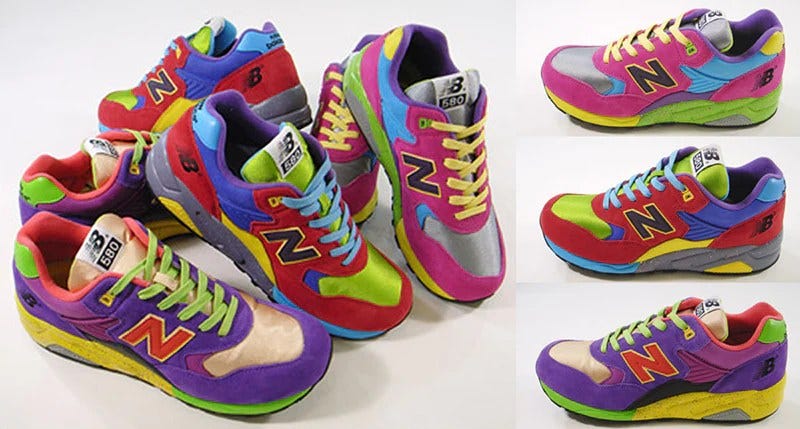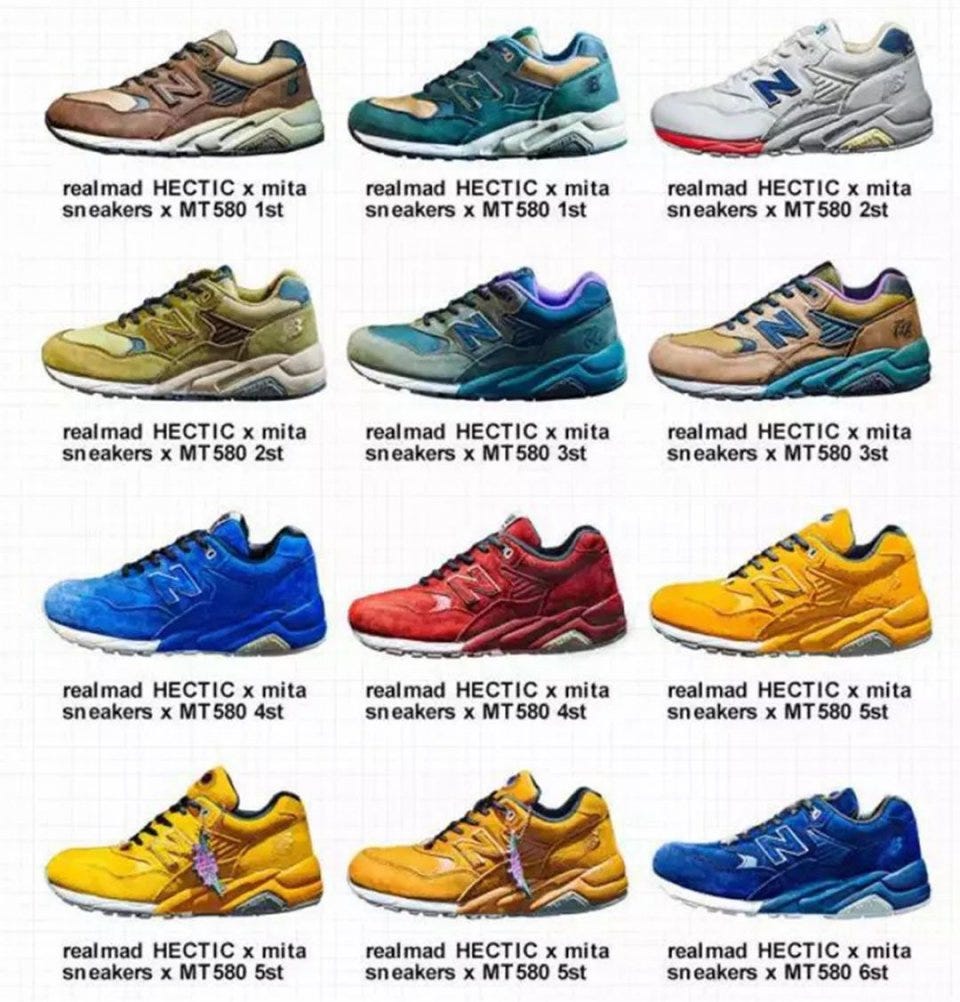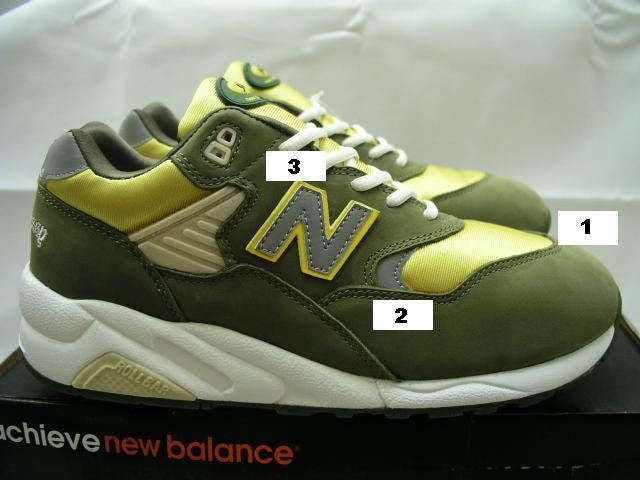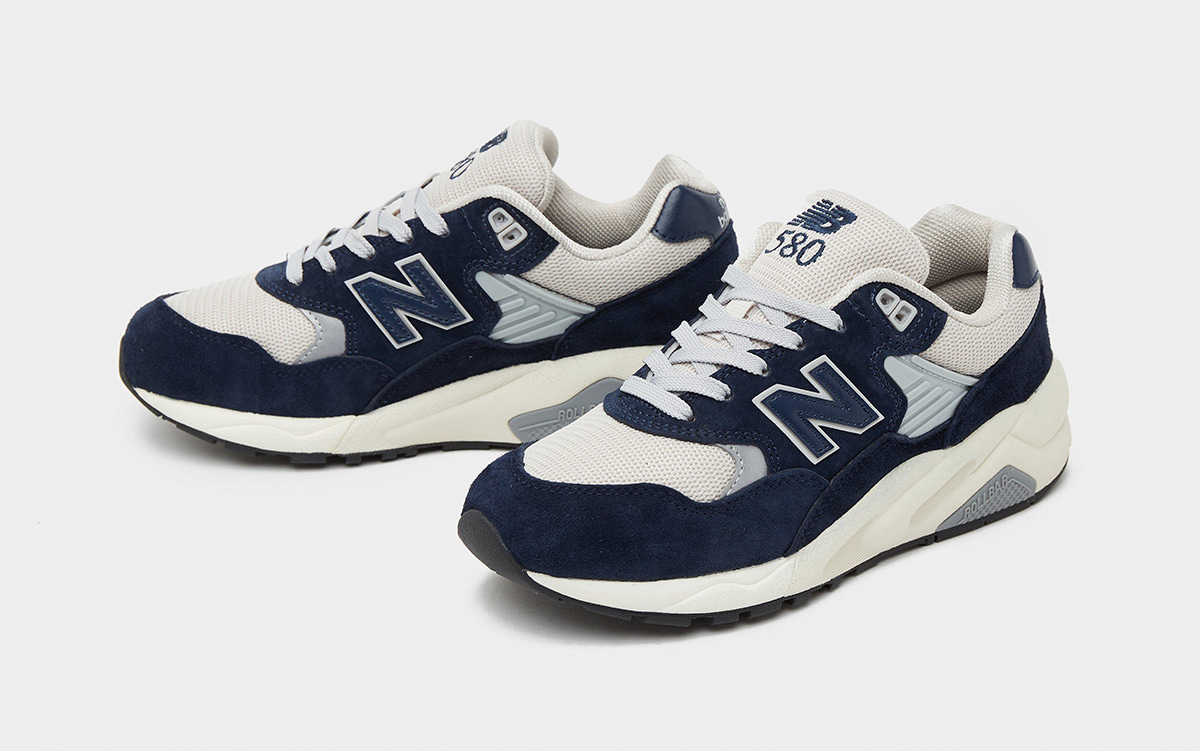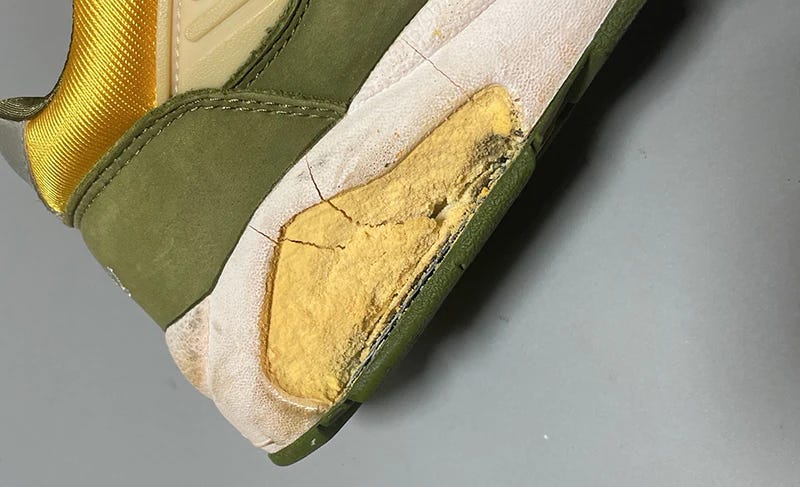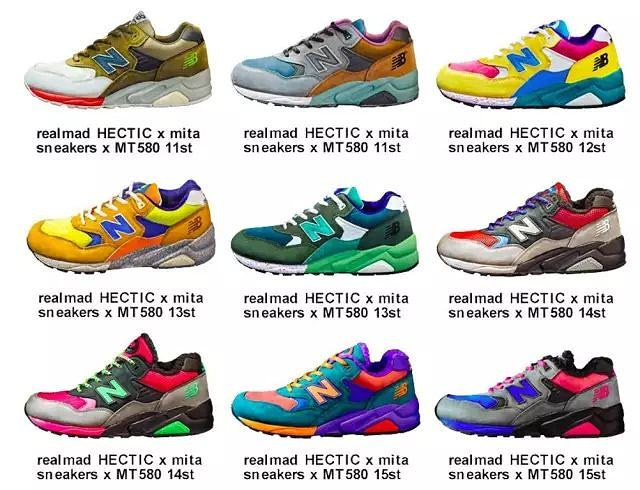I’m not sure whether it’s my age or the general state of affairs, but I keep returning to early 2000’s streetwear brands lately. I find myself flicking through old Bape and BBC/Icecream lookbooks reminiscing about the good ol’ days – an issue not made any easier by Pharrell’s recent JOOPITER auction.
When Stray Rats dropped their multicoloured MT580s with a forum-inspired photoshoot (complete with DaFont typefaces) I felt seen. It transported me back to the Crooked Tongues forums and copy/pasting YahooJP auction descriptions into Google Translate.
To me they clearly referenced the 2006 ‘Triple Threat’ MT580s from UNDFTD, Stüssy and realmadHECTIC.
Personally, this trio perfectly encapsulate the early-2000s sneaker scene. It wasn’t underground anymore, but people were still relatively care-free. It felt like the brands hadn’t really ‘got it’ but they knew there was potential. In that moment; stores, collaborators and consumers seemed to hold the power. There weren’t really any ideas too wild. It was all a far cry from the trend-forecasted, focus-grouped and sales-projected stranglehold of today.
Even though the MT580 never worked for me (the ROLLBAR never jived with my feet) I often catch my mind wandering to those Triple Threats. They’re a ‘would be nice’ thing devoid of practical consideration. Objectively, the later green version is probably the best, but each its charms.
Originally released in 1996, the MT580 was conceived by New Balance Japan as a price-point shoe to capture a young consumer. The brand had a strong foothold in the post-war demographic, but American-made product was too expensive for the younger audience. The plan was to produce the ‘Made in USA’ M585 in Asian factories and sell it exclusively in Japan. Relatively speaking, the MT580 was a carbon copy of the M585, down to the distinctive ROLLBAR™ midsole.
All of this strategy didn’t matter, the MT580 wasn’t the success NB had hoped for. The wild midsole appealed to fashion kids but retaining the ROLLBAR meant the price was too high for Japan’s thrifty youth. Testament to how badly the plan went, it was impossible to find a single pair after scouring hundreds of Harajuku street style photos. As New Balance readied to discontinue MT580 though, something clicked…
Once they hit factory outlets Urahara kei [裏原系] fashion kids — who obsessed over American skate and hip-hop style while hanging out in the backstreets of Harajuku — flocked to the M585 lookalikes. They started pairing them with upcoming Urahara brands like Undercover, A BATHING APE®, Neighborhood and GOODENOUGH. As Urahara kei started to spread through Harajuku the MT580 finally reached the youth. After a false start, there was a hope.
Things would change 1999, when New Balance Japan conceived a unique relationship with retailer Mita Sneakers in Ueno and Tokyo brand realmadHECTIC. They turned to the people who knew what the kids wanted, offering a chance to design exclusives for their customers. It came as a surprise to NB when they opted to use the MT580 — they’d spent years trying to make the shoe work to no success. Together they created co-branded colourways, launching a concept which would change the industry forever — sneaker collaborations. Whilst not the first co-branded NBs, these were more than corporate swag.
[Theory⌁Break]French philosopher Gilles Lipovetsky identified two distinct phases of modern fashion. Through to the ‘50s fashion aligned with the status-quo, continuing defined norms as we strived to fit in. People wanted to look older to be taken seriously.
As the counter-culture movement swept through universities in the ‘60s, it took with it the desire to conform, and for the first time young people didn’t want to look older. In this context, it wasn’t until New Balance engaged Mita and madHECTIC that the MT580 popped-off.[/Theory⌁Break]

Although it’s hard to believe today, producing a shoe with anyone other than a sports star was a totally foreign concept. These new collaboration shoes were selling youth and exclusivity, not a cut-price continuation of the norm. The script had been flipped.
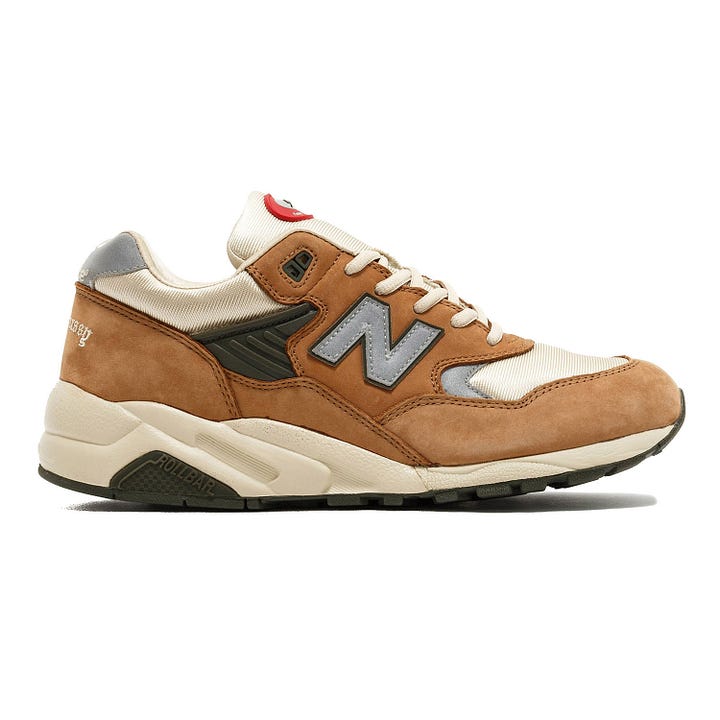

The MT580 finally entered the zeitgeist when Stüssy joined the conversation in 2004. By transplanting the colours from their Nike Huarache collaboration onto the 580, Stüssy catapulted the model into the streetwear lexicon. Whilst the all-Japan efforts had succeeded in creating localised demand, Stüssy’s addition saw the hype cross international waters.
At this point the co.jp sneaker craze was kicking off thanks to Nike’s regionalised Dunks and Air Force 1s catching the eye of touring rappers. As BAPE and the other Urahara kei brands benefitted from the international obsession with Japan, the MT580 gained notoriety as well. Paired with Stüssy’s OG status in the industry, the ‘Mad Stüssy’ MT580s had people scrambling to find a Japanese proxy. These were hyped enough that I remember there being counterfeits at a time when faking NBs was a laughable concept.
Through all of this, something was lost. As the MT580’s reputation peaked, NB finally released it outside of Japan in 2010 through a series of collaborations. Outside of collabs though the model struggled — much like in 1996. The exotic appeal of the MT580 was undermined as mainstream consumers, put off by the odd look and middle-ground price, opted for entry-level 574s and flagship UK/USA product. Devoid of the Japanese context, the MT580 was just an odd shoe which cost more than a pair of Air Max.
For the next few years New Balance tried different approaches; creating a stealthy REVlite midsole and a few unfortunate pairs with re-tooled uppers, all to underwhelming result. The standard REVlite version wasn’t bad — the foam was a perfect upgrade to the CT300 – but removing the ROLLBAR felt wrong. Eventually they would hit outlets and disappear. It seems one thing western consumers do better than Japan is running a shoe out of town.
Years later, decades since the Japanese launch, New Balance is back for another crack. Kicking things off with Stray Rats proved fortuitous insomuch as they respected the legacy. Whilst pairs sitting online is encouraging given resellers largely ruined the act of buying shoes, I can’t help but feel anxious about the 580’s track record.
Things have started well though and I’m glad they released the original navy. We’re yet to see whether this time proves successful though. The 990v2 (an ugly duckling with no real cultural cache) has managed to find buyers, so stranger things have happened. I do wonder if they’d do better to reboot the ‘Made in USA’ M585 instead. High prices and patriotism seem to work well in this market. I do wonder if the MT580 was best left in Japan, a cultural oddity to be brought back as a souvenir by worldly travellers.

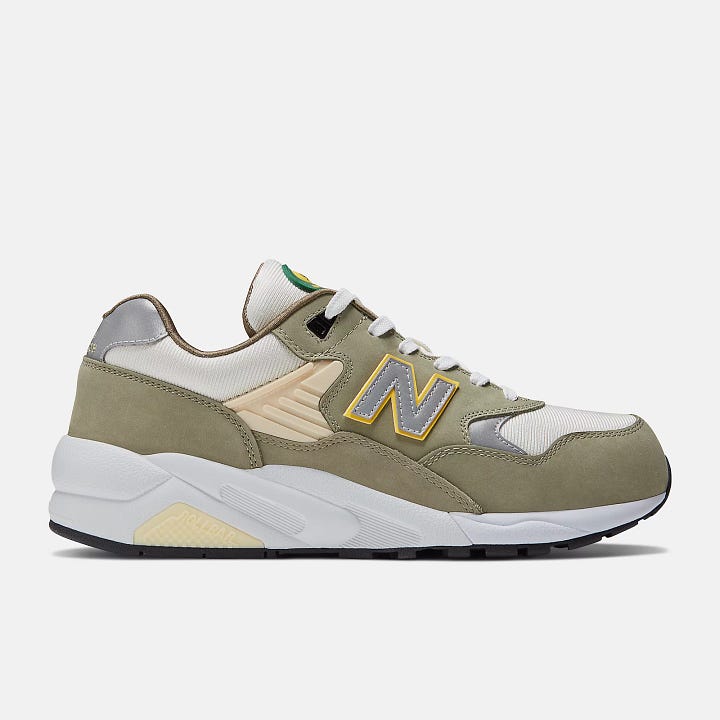
The bulk of this post was inspired by these particular MT580s. Clearly an ‘homage’ to the Stüssy duo, by swapping mesh colours and leaving off the all-important embroidery they’re more ‘un-Stüssy’ than retro. A nod to the ‘04 partnership without a need to pay royalties…
In a way it’s representative of the current market — testament to good design’s enduring appeal whilst mournful of simpler times. Everything seems trapped in stasis with no clear way forward, paralysed by corporate interest. When the original Stüssy 580s dropped it was a time of excitement and hope — wondering where things might take us. Now we’re stuck buying our memories back at a premium.
As is often the case, I found myself going back to the sage words of the late Gary Warnett. Gary lamented the global release of the MT580, positing that westerners simply weren’t built to appreciate it. Like myself, Gary thought the MT580 was best left in Japan — a reward for those willing to bring a pair across from the far-east.
I know plenty (myself included) who owe their livelihoods to this industry. That success has come at a cost though. We commodifying our passion in order to survive. Sometimes it comes at the expense of the very thing we loved in the first place.
It’s fine though. Young people will tire, move on, and find something new. The cycle will start again.
Youth will always win.





